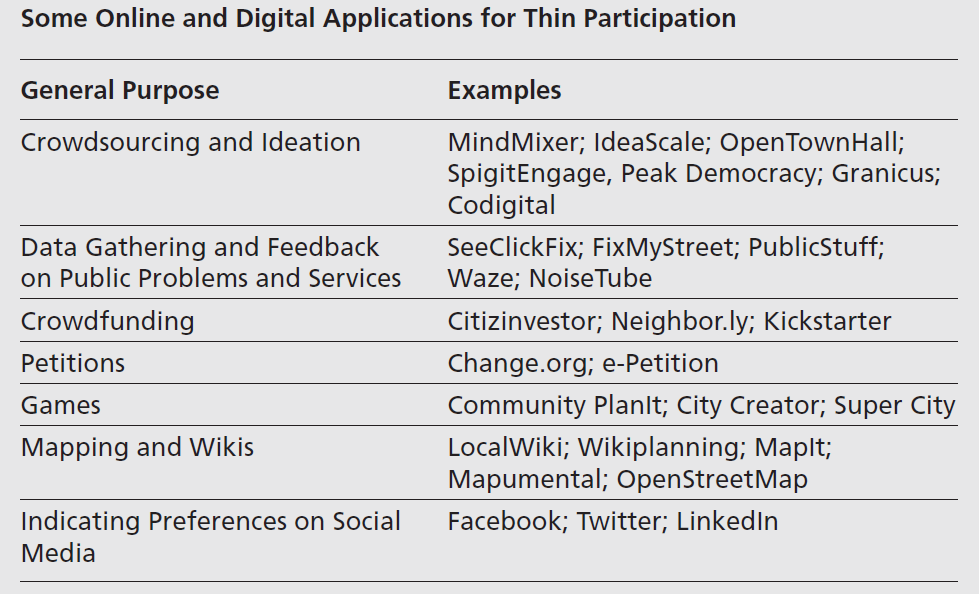Mod 8 Readings
Good or Bad? Charming or Tedious? Understanding Public Participation
Purpose: to describe, analyze, categorize the main forms of engagement so that readers can understand how to judge quality of participation (good or bad)
Three forms of participation (thick, thin, conventional)
Defining Public Participation and Exploring Its Modern Forms
Definition: Public participation is an umbrella term that describes the activities by which people’s concerns, needs, interests, and values are incorporated into decisions and actions on public matters and issues.
Types of DP: thick, thin, conventional
Thick Participation
Enables large numbers of people, working in small groups to learn, decide, act—most powerful and most time consuming, least common
Can be done through deliberation (discussion about views to make a decision based on facts/emotions/etc.) or dialogue/debate
Outside-the-room Factors
Proactive, network based recruitment (attracts many people, reach out to influential people who reach to constituents, organizers pay attention to recruiting people who are affected by issue/prolly won’t attend —> participants hear abt process from people they know/trust)
Small group facilitation (facilitators guide discussions and lay ground rules)
A discussion sequence (sharing experiences to considering views/policies to planning action)
Issue framing (describes the main views on the issue being addressed)
An action strategy (helps participants/officials capitalize on energy/input generated throughout the process)
Another strategy of TP is ‘serious games’ that simulate real world events to educate users and solve problems. (video games)
Face-to-Face processes for TP
Citizen assemblies and juries
Participatory budgeting
Study Circles
Open Space
Online platforms for TP
Dialogue App
MetroQuest
Engagement HQ
Zilino
Thin Participation
Activates people as individuals not groups. Historically, that was petitions/surveys but now is an e-petition, like or repost, donations etc.
Motivation comes from feeling like a part of a larger movement/cause—sometimes activities go viral through Internet networking
Thin participation requires shorter time commitments and less intense intellectual/emotional contributions
Thick and thin participation isn’t just face to face versus online: both are interchangeable
A visitor to a crowdsourcing platform can take either two minutes or many hours commenting and voting on ideas
3 B’s of open data (Mark Headd) draw people to these platforms
Bullets (crime statistics), budgets (city expenditures) and buses (public transit schedules)
ThP has more variety than thick/conventional processes and give these opportunities:
Affiliate with a cause, rank ideas (for solving a problem), donate money, play games (educational/gather input), provide discrete pieces of data (to identify issues or improve services)
All of these allow individuals to express ideas/opinions that requires only a little of their time (still requires recruitment to attract people)

Both have limits: thick = temporary, not incorporated into larger plans. thin = isolated products not incorporated into larger plans.
“thick engagement doesn’t ‘scale,’ and thin engagement doesn’t stick”
Direction is to combine best features of both types that can be replicated and embedded in communities.
Conventional Participation
older forms of engagement that were developed to uphold order, accountability, and transparency
Most common type b/c it is entrenched in public institutions/law (official participation—not just governmental can be HOAs or PTOs)
Described mostly as meetings/hearings by public bodies (school boards, city councils). Reliance on common procedures:
Advance notification (bulletin/announcement on website/news), audience-style room (leaders at front, citizens in rows), a preset agenda (strictly followed), and public comment segments (2-3 mins to address officials).
This form of government is tedious/frustrating.
Why Does Conventional Participation Cause Problems?
Do not succeed in upholding public values of transparency, accessibility, and accountability.
Reasons why: transparent practices do not lead to the sense that public officials are receptive, and citizens do not attend.
Leaders trying to fix that issue usually only do so in times of crisis with a temporary/limited project
Problems with conventional participation:
Conventional participation can be harmful to citizens—makes them feel powerless, decreases interest/trust in govt. May also inc polarization, creating extreme positions.
Decline in attendance is not apathy, but a decision based off calculating costs/benefits
Conventional participation can harm administrators and public officials—organization/preparations are costly and tiring. Dealing with hostile citizens.
Conventional participation can harm policy and governance—scholars say that public meetings don’t actually involve citizens and public participation may actually degrade quality of decisions/policy implementation.
Overall, deterioration of people-public link —> decline in legitimacy and financial sustainability of governments. Attempts to reframe is through good participation.
What is Good Participation?
Means “treating citizens like adults.”
Ways in which good participation activities (thick and thin) can show respect, responsibility:
Providing factual information—basic stuff about public problems, budgets, services through printed handouts, infographics, presentations.
Giving people a chance to tell stories—making people feel heard, relate experiences and learn from one another. Small groups